I recently wrote an article about living walls for GreenHomeBuilding.com, and in doing the research for this I came upon an interesting approach to creating a kind of living wall or retaining wall using geotextile materials. Basically, loosely woven bags filled with a growing medium can be stacked to form walls that then support plant growth.
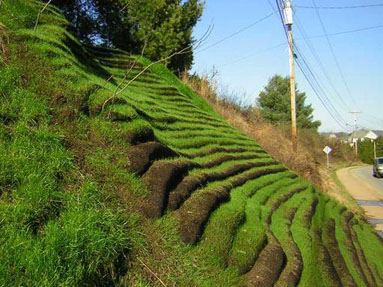
One company in particular, www.filtrexx.com, has been selling various systems for doing this for some time. This is a green alternative to hard-faced walls, and can create walls that are either completely vertical or slope up to 2:1. A variety of vegetation can be supported this way, depending on the location and purpose of the wall. They say that this is faster to install than conventional block materials used in retaining walls.
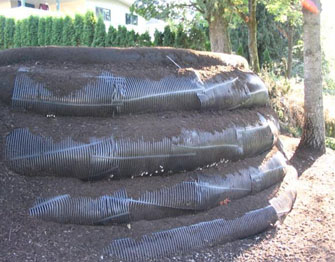
But if you look at the basis of the concept, it is not that different than building with earthbags: bags of material are stacked to form walls. But in this case, the bags are then protected by the plants that grow out of them, and this vegetation becomes the exterior interface with the environment, providing oxygen, filtering the air, and looking beautiful.
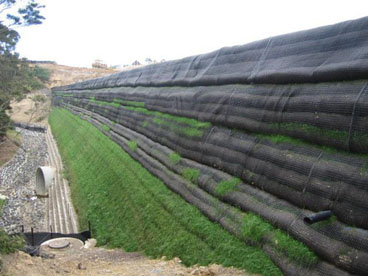
So how might this idea be utilized for buildings? Obviously the main issue is the moisture that inevitably will migrate into and through the wall to the interior space…unless there is some way to stop it.
One approach might be to build the earthbag structure as is frequently done, with compacted soil, and then cover this with a waterproof membrane to protect it from intruding moisture. A second skin of a “living wall” could then be applied over the membrane, both as protection for the earthbag structure, and as an insulating layer.
This would create the ideal situation for climate-responsive housing, where the inside is composed of thermal mass materials, and the shell of the structure is insulated to keep the interior from loosing its comfortable temperature.
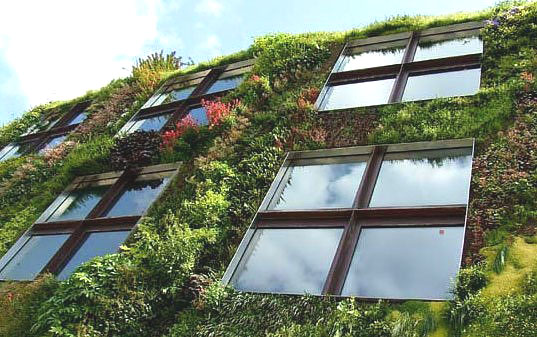
Besides using the geotextile bags, it is also possible to use one of the variety of systems that have been devised for creating living walls that are attached to buildings, as shown above. Many of these sophisticated systems automatically provide the necessary water to maintain the plants, so there is very little maintenance over time.

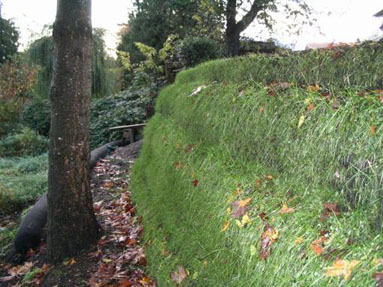
Hi Owen,
I’m currently planning on making a vertical wall garden using geotextile. The idea is to make pockets of geotextile sewn on a large sheet of geotextile. What gsm do you recommend I use?
Contact suppliers with similar products for retaining walls and use similar fabric. Some of these have been covered on our blog. Search for keywords such as Retaining Walls. Here’s one example: https://naturalbuildingblog.siterubix.com/living-walls/
Hi Owen
I’m thinking about terracing my sloped garden by creating a number of earthbag retaining walls. Ideally I’d like to cover them with vegetation rather than plastering them. Do you have any experience of this?
Do you know if woven PP bags are root permeable? I would hope that by planting on the bags it would promote root growth to further stabilize the walls, but I’m concerned that I may have difficulty keeping seeded soil in place on top of the bags. I plan to fill the bags with a 70/30 sand/soil root zone mix.
There are some (pricey!) products on the market being sold for this purpose, but i notice their specs state that their PP bags are non woven – what’s the difference? They also advocate ‘live planting’ which involves making small cuts (up to 3 in the top third of the bag) to insert plant plugs – am I right to think this might compromise the integrity of my wall?
Thanks
Regular poly bags will disintegrate in sunlight in about two months. You need to either plaster the bags and plant behind the wall or use special bags/tubes for living walls.
I’ve always been slightly wary of ‘green wall’ systems piggybacking on the sustainable agenda – in most applications, the energy required to build, water and maintain a green wall on a conventional building has a significant energy load which is often in direct opposition with the architect’s stated aim of ‘sustainability’. The environmental benefits to the local atmosphere of cities is a separate issue, and possibly the main area of merit for this type of construction.
The possibility of building thermally massive buildings from geotextile bags is possibly the antithesis of the ‘green wall’ systems comprising a watered framework as cladding for office blocks and similar – and possibly a good idea! Whether, from a global perspective, there is much different between an ‘earthship’ type building and an ‘earthship’ type building with grassy outer walls is another question entirely!
Nevertheless, nice post and great to be aware of this type of technology.
Excellent post. Thanks for the information.
Readers might be interested in my green wall concept home called Green House: http://earthbagplans.wordpress.com/2009/03/07/green-house/